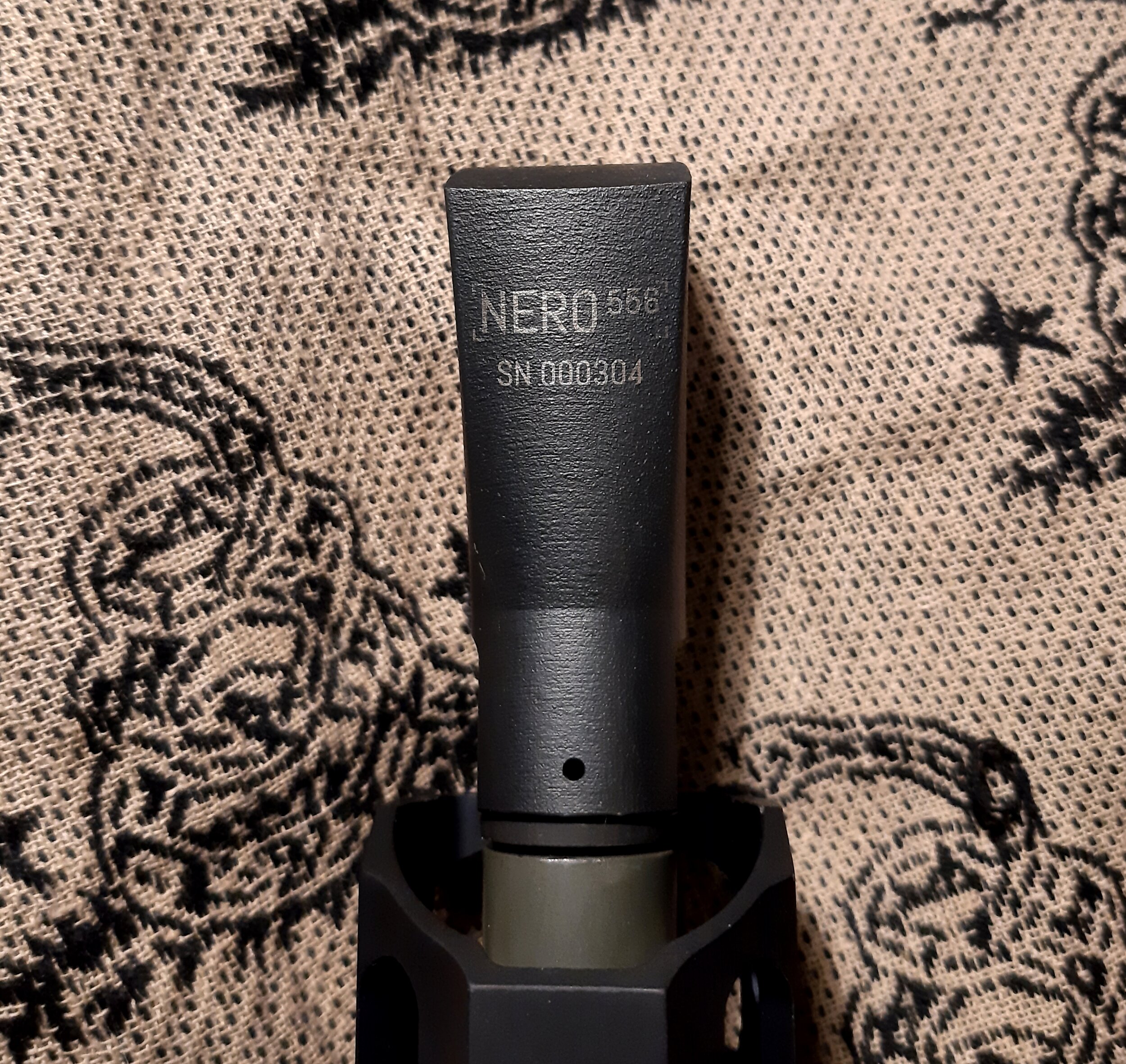I was looking at building a lightweight AR pistol, using off the shelf parts, that wouldn’t break the bank. Part of what I needed was a lightweight barrel. Faxon Firearms had exactly what I was looking for with their 10.5” pencil profile barrel. As a bonus, Faxon threw in their slim profile muzzle brake. So off to assembly I went.
When the Faxon barrel first arrived, I weighed it on my scale. There’s a few reasons for this. First, I wanted to know the actual weight. The barrel alone weighed in at 14.53 ounces, so not even a pound. The same barrel in a 16” weighs about 20 ounces. Second, this Faxon barrel comes with a gas block, but no gas tube. Because I figured I wanted a total weight, I weighed it with a gas tube and the supplied gas block. Total usable weight was 16.26 ounces, so essentially a hair over a pound. Speaking of the gas block, a really cool thing about it is the pre-drilled hole so you can pin the gas block on with the supplied pin. The gas block also has set screws on the bottom to tighten it up. Having a pinned gas block is especially nice if you are expecting any type of hard use situations.
The Faxon pencil barrel specifications are pretty standard. This one has a pencil profile. It is made from 4150 CMV steel, has a 5.56 NATO caliber and is 1:8 twist button rifled. Faxon QPQ Nitrides the whole barrel for corrosion and wear resistance. Because it’s a pencil profile, Faxon uses a 0.625 gas block diameter. Being a 10.5” length, it uses the carbine length gas system. To quality control their barrels, Faxon magnetic particle inspects them so that good barrels get sent out to the user and bad ones don’t. Lastly, the barrel is threaded the standard ½-28 and has a recessed target crown.
Faxon also sent me one of their Slim 3-port muzzle brakes. This particular muzzle brake has an outside diameter of 0.620”. It screws directly onto the barrel threads and comes with a crush washer. The small outside diameter of this brake makes it possible to remove the gas block without removing the muzzle brake. This can be especially nice if you have to pin and weld a muzzle device on to meet a legal length. It is 2.125”’ long, so it will bring a 13.9” barrel to the legal 16” length. I however am using this on a pistol, so no need to pin and weld. When installing the 3 port muzzle brake, be extremely careful as the metal is softer than I realized. I rounded the corners of it with an open end wrench trying to time it properly with the supplied crush washer. Make sure your wrench is on the solid portion, not over a port. That crush washer is stronger than any I have seen. Besides my error in installation, the 3 port design actually works very well. I was a little hesitant due to the smaller size, but it performs as well as other 3 port comps I have used. It actually tamed the little 10.5”’s recoil down some. Now it is loud, but all compensators like this are. The slim brake also only weighs 1.12 ounces.
The Faxon Lightweight barrel combo serves its purpose. I put it through some use during a “range day.” This is a training style match that the local club has. The barrel and comp both performed well with zero hiccups. Now that can’t be said about the shooter. I also did some accuracy testing at 100yds. The barrel averaged about 2-3” groups with normal ammunition. As expected, as the barrel heated up a little, the groups would string some, but I included it in the group sizes, so you can tell it’s not terrible. For a 10.5” barrel, the accuracy is fine for me because I don’t expect to use this pistol past 100 yds anyhow.
If you are looking into a super lightweight barrel, definitely check out the Faxon line of barrels. They are one of the few that come with a pinned on style gas block. The 10.5” barrel and gas block were just the lightweight stuff I was looking for. While you are over at Faxon, don’t forget to look at the slimline comp too.
Firearms Insider Reviews - 8 Key Points
Claim to Fame:
Short lightweight barrel with a pinned gas block
Target Market:
Builders wanting a super lightweight barrel/gas block combo
FNBs (Features & Benefits of this product):
Barrel:
4150 CMV
Button Rifled
5.56 - 1:8 twist rifling
10.5" Pencil profile
Carbine length gas system
QPQ Salt Bath Nitride finish
1/2-28 threaded muzzle
.625" gas block diameter
Gas Block Journal Length: 1.1"
M4 barrel extension
Magnetic Particle Inspected
11-degree Target Crown
Barrel weighs 14.53 oz
Weight with gas block and gas tube is 16.26 oz
Pin on gas block
Comp:
QPQ Salt Bath Nitride
Thread: 1/2"-28 TPI
Weight: 1.12 Ounces
Length: 2.125 Inches
Outer Diameter: .620”
Caliber: .223/5.56
What other aesthetic options or finishes are available?
Different lengths and calibers
What others are saying?:
5/5 stars at FaxonFirearms.com
Top shelf quality. As a toolmaker I can pin a gas block but for the money it's not worth me setting up to do it. Beautiful work
Link to other reviews:
Closes I could find was for the 16” pencil barrel - HERE
Price point:
MSRP:
Barrel - $195.00
Muzzle Brake - $59.99
Retail: Probably a little cheaper if you can find the same combo
I need it now! Availability:
Our Rating:
Pros:
Super light
Pinned gas block
Optional muzzle brake that matches barrel
QPQ Nitride finish
Cons:
Accuracy
Score: 8.00 Great
Favorite Link: Gun Guys Garage























